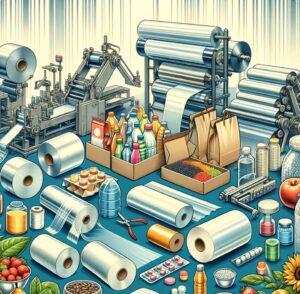Value Investing
If you’re looking at equities, NSE leads, but BSE offers niche opportunities. For commodities, MCX is the top choice, while NeML is revolutionizing rural markets with digital solutions.

Jindal Poly Films and Uflex Ltd are leading entities in the flexible packaging and films industry, with Garware Hi-Tech Films also playing a significant role with its specialized film solutions. Jindal is recognized for its extensive production capacity in BOPET and BOPP films, focusing primarily on packaging applications. Uflex distinguishes itself with a broader array of offerings, including flexible packaging, aseptic liquid packaging, holography, and engineering services, catering to diverse sectors. Garware, though not detailed here, is known for its expertise in polyester films, catering to niche markets with innovative products.
Jindal Poly Films Ltd:
Uflex Ltd:
Garware Hi-Tech Films (based on known information):
Jindal Poly Films Ltd:
Jindal Poly Films Ltd has demonstrated various financial metrics that offer insight into its performance and financial health. The company has a current share price of Rs 530.05, and it shows a return on assets (ROA) of 26.70%, which is a robust indicator of its efficiency in generating profit from its assets. The company’s current ratio stands at 11.27, suggesting strong short-term liquidity and the ability to cover its short-term liabilities with its short-term assets.
Jindal Poly Films Ltd has a return on equity (ROE) of 37.59%, highlighting its ability to generate profits from its shareholders’ investments. However, it is essential to note that the company’s debt to equity ratio is 0.1376, indicating a low proportion of debt in its capital structure, which is generally a positive sign regarding financial stability. Despite these strong indicators, the company’s inventory turnover ratio is 5.37, suggesting room for improvement in inventory and working capital management.
For the third quarter of the fiscal year 2023-2024, Jindal Poly Films Ltd reported a revenue of ₹1,113.01 crore. However, it experienced a net loss of ₹19.41 crore during the same period, resulting in a net profit margin of -1.74%. When comparing year-on-year performance, these results mark a significant change, especially in net profit margins.
Overall, while Jindal Poly Films Ltd shows strong ROA and ROE figures, the negative net profit margin for the recent quarter indicates challenges that the company needs to address. Investors and stakeholders would need to consider these varied aspects to gauge the company’s overall financial health and potential future performance
Uflex Ltd:
UFlex Ltd reported its Q3 FY 2024 financial results with some notable figures and insights into the company’s performance during the period. The company’s unaudited consolidated net revenue stood at Rs. 33,454 million ($4.03 billion), reflecting a decrease of 1.3% quarter-over-quarter (QoQ) and 4.3% year-over-year (YoY). Despite these declines, UFlex saw an increase in its adjusted EBITDA to Rs. 4,258 million ($512 million), which is up 0.4% QoQ and 4.3% YoY, with an EBITDA margin of 12.7%, showing an improvement of 70 basis points (bps) QoQ and 50 bps YoY.
The third quarter of FY 2024 highlighted growth in volume and profitability, reaching $2 billion. UFlex experienced a 5.8% YoY growth in overall sales volume, including a 6.5% increase in its films business and a 3.6% increase in its packaging business. Liquid packaging was a significant growth driver for the packaging segment. The report also mentions the challenges faced due to global geopolitical uncertainties and economic conditions affecting various markets, including emerging economies like Egypt and Nigeria, which are significant for UFlex’s packaging films business.
Garware Hi-Tech Films
Jindal Poly Films aims to consolidate its leadership in the packaging film segment, leveraging its scale and technological edge.
Uflex is aggressively pursuing innovation and sustainability, developing products like 100% PCR content films and contributing to sectors beyond packaging, such as space and recycling technologies.
Garware Hi-Tech Films, though not detailed here, presumably continues to focus on product innovation and niche market penetration.
Jindal Poly Films:
Uflex Ltd:
Garware Hi-Tech Films:
Jindal and Uflex attract diverse investors due to their scale, innovation, and market presence. Their customer base spans across various industries globally, reflecting their market penetration and reach.
Garware likely attracts investors interested in niche markets and specialized applications, with a customer base focused in specific sectors where its films are critical.
The industry outlook for all three companies remains positive, given the increasing demand for innovative and sustainable packaging solutions. Market capitalization would be influenced by their operational efficiency, market expansion, and innovation capabilities.
If you’re looking at equities, NSE leads, but BSE offers niche opportunities. For commodities, MCX is the top choice, while NeML is revolutionizing rural markets with digital solutions.
Mastek, Persistent Systems, KPIT, and Mphasis cater to different IT segments. KPIT leads in automotive software (high growth, expensive valuation). Persistent is strong in digital transformation, Mphasis in BFSI, and Mastek in cloud ERP (UK-focused). Persistent offers a balance of growth and valuation, while KPIT has industry tailwinds.
Kaveri Seeds, UPL, Bayer CropScience, and Rasi Seeds are key players in India’s agribusiness sector. Kaveri and Rasi dominate hybrid seeds, while UPL leads agrochemicals. Bayer excels in biotech but faces regulatory hurdles. UPL offers high growth but carries debt, while Kaveri and Bayer provide stable investment potential.